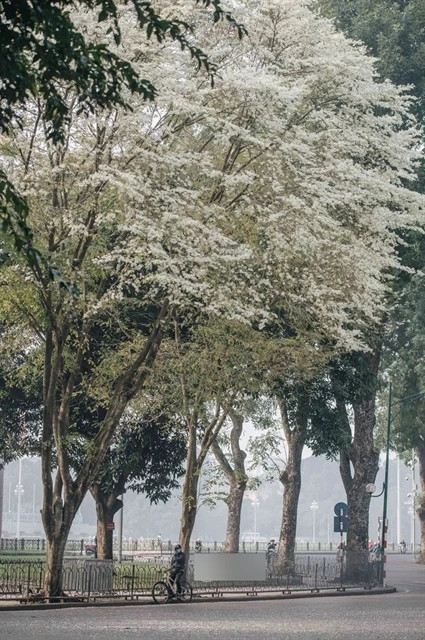More than 25,000 trees were uprooted across the city, including beloved ones that had been cherished by both locals and tourists.
Iconic locales, celebrated for their enchanting and photogenic spots framed by ancient trees and lush greenery, now bear the scars of rain and wind following the typhoon.
The most beautiful fragrant rosewood tree located at the roundabout where Dien Bien Phu street intersects with Chua Mot Cot street – a cherished spot for photos during its flowering season – succumbed to the force of the wind.

Architect Huynh My Hanh said she used to take her three teenage daughters for photos with the tree whenever it was in bloom, adding that she feels regretful.
She said that when she shared the news about the tree with her girls, their feelings were same as their mother – quite sad.
“They said that it’s heartbreaking to lose such a ‘natural landmark’, especially one that held so much beauty and significance,” Hanh said.
Among the other 'landmark' trees that couldn’t withstand the typhoon are the two ancient trees on Nha Tho street right in front of St Joseph's Cathedral.
Like every Hanoi resident, Nguyen Trang, a makeup artist and photographer, has been keeping up-to-date on the situation regarding typhoon Yagi. When the storm hit the capital, she learned through the news that many large trees, including several ancient trees, had been uprooted by strong winds. However, the two venerable old trees near the cathedral are what she regrets the most. Just one day before the storm, she had taken clients there for a photoshoot.
Trang insists that this spot in Hanoi is one of the most enchanting locations for photos in the autumn.
“Here, the historic cathedral and neighbouring French-styled houses frame a scene where lush foliage and tree roots weave a romantic tapestry. At dawn or dusk, sunlight filtering through stained glass windows bathes St Joseph’s Cathedral in a shimmering, magical glow. It’s no wonder photographers consistently recommend this serene and poetic setting to their clients,” she said.
Trang can now only glimpse these trees solely through the photos she curated for her clients.
Meanwhile, locals are lamenting missed opportunities, as they had intended to visit the place for photos, but never got the chance.
”It’s bittersweet, isn’t it? The way memories and unfulfilled plans intersect in our minds,” said Quang Huy, a photography enthusiast.
Beyond selling cameras and photography gear, Minh Duc doubles as a local lensman in Hanoi. His lens wanders to popular spots like Hoan Kiem Lake, St Joseph’s Cathedral and charming Phan Dinh Phung street. In these places, lush greenery dances with sunlight, weaving a picturesque tapestry – a favourite haunt for capturing beauty through the viewfinder.
Duc insists that the two old trees on Nha Tho street etch a unique impression on both locals and tourists.
Across the seasons, Duc has returned to this spot, shutter clicking, countless times.
“I cannot pinpoint when the trees transformed into a compelling photo subject. And so, when news arrived of their fall, an ache settled – an emptiness where once a beautiful image thrived,” he said.
Phan Dinh Phung is one of Hanoi's most enchanting tree-lined streets, where young people frequently strike their ‘muse’ poses. Bicycles adorned with flowers or the golden foliage of autumn serve as artistic companions. But after typhoon Yagi’s tempestuous visit, the once-familiar street revealed a distressing scene, with fallen trees and their grizzled roots upended by fierce winds.
“It’s heartbreaking to see the aftermath of such natural disasters, especially when they affect the natural space of a place,” Trang said.
A few years back, a photo featuring a jackfruit tree standing sentinel near the United Nations guardhouse in Hanoi went viral on social networks.
Netizens affectionately dubbed it ‘The Safest Jackfruit in Vietnam’. Despite its low-leaning trunk propped up by metal pillars, the tree ultimately succumbed to the fierce winds of the typhoon./. VNA